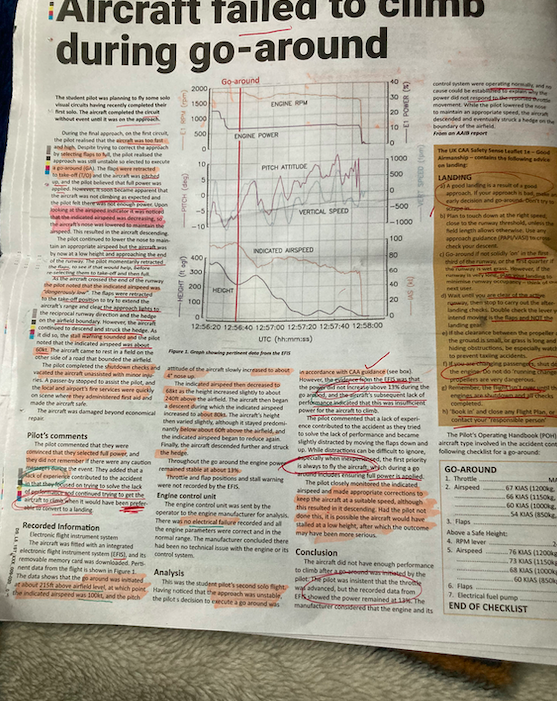
Go-Around Failure: Reflections From A Student Pilot & Lessons To Learn
In this blog I will talk about an incident involving an aircraft and a student pilot. I read this recently in a newspaper and thought it’d be good practise to share and for us all to take away lessons from this experience.
Background
The student had already completed his/her first solo. Planning to fly a few solo circuits the pilot approached the airfield for a touch and go. During the final approach, the aircraft was too high and too fast. To correct this the pilot selected full flaps – Unfortunately poor correction was achieved and the pilot initiated a go-around (GA).
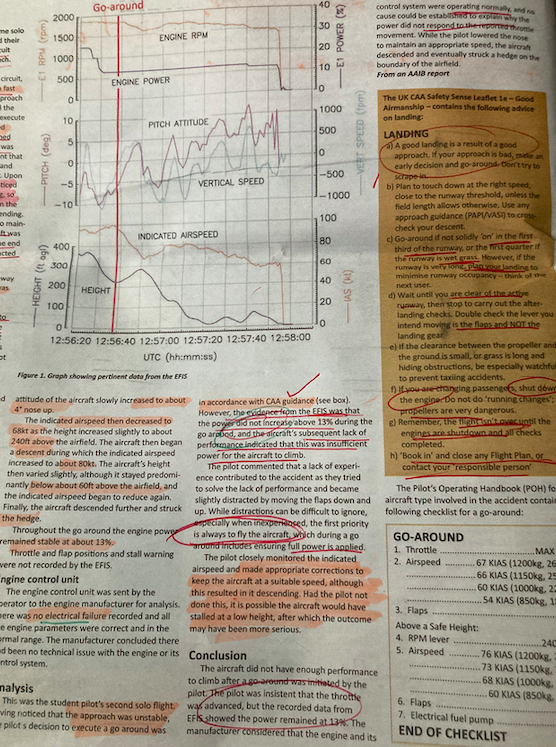

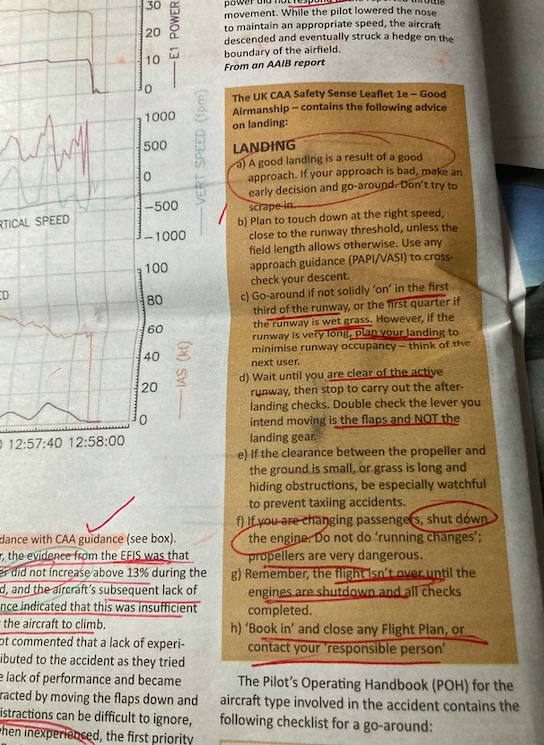
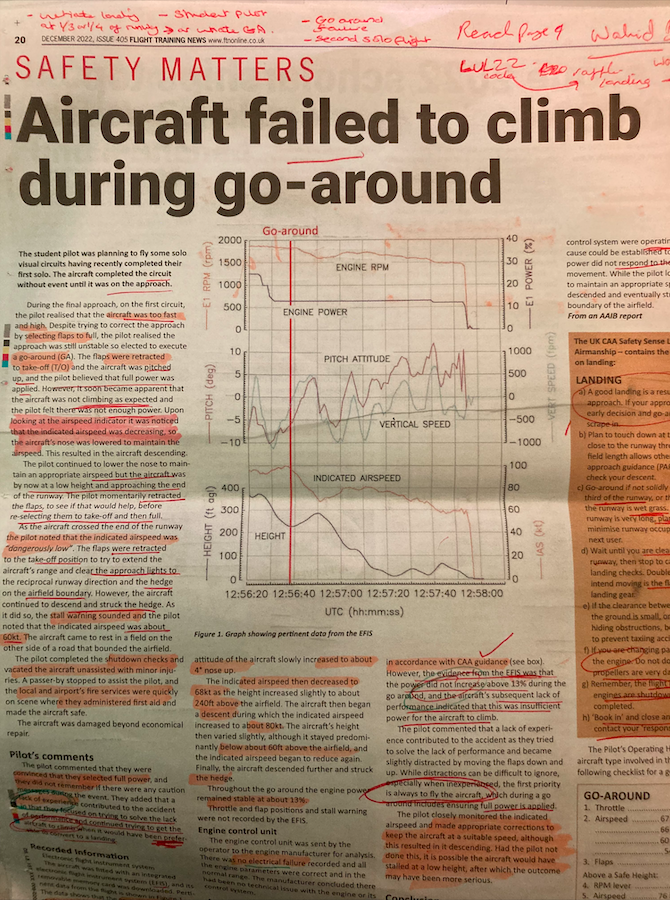
To initiate the GA the flaps were retracted to take-off (TO). The aircraft was pitched up and full-power was applied. However, shortly after the pilot noticed the plane was not climbing as it should and the indicated airspeed was decreasing – to address this the aircraft was pitched down to maintain airspeed. This lead to a steeper descent with the aircraft reaching towards the end of the runway. Later on, flaps were momentarily retracted, extended to TO position and then to full position.
At this point the aircraft was dangerously low – flaps were retracted to TO again to extend the aircrafts range in order to cross the hedge and approach lights. Despite this the aircraft hit the edge and came to rest at a field. Following the incident, the student was certain full thrust was applied – but the aircraft failed to respond to that.
Cockpit data
Electronic flight instrument system (EFIS)
The aircraft was fitted with an EFIS. The data shows as illustrated in the image:
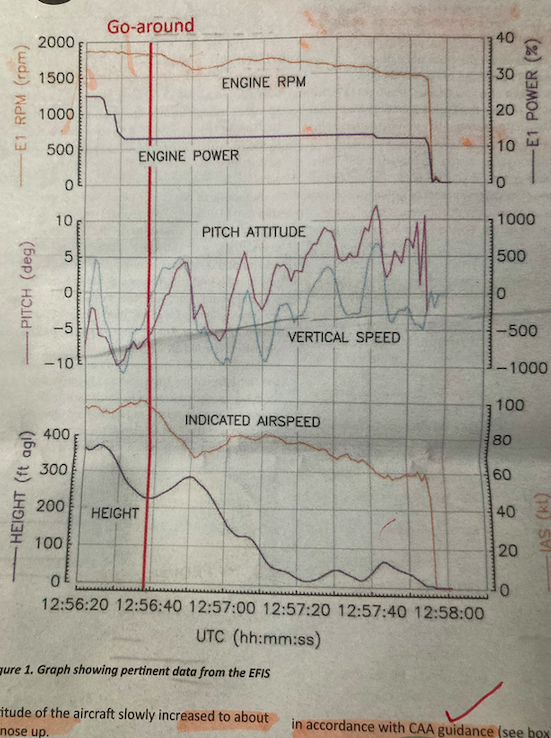
In summary the following events took place:
- Student completed a circuit – intended for a touch and go.
- Due to unstable approach – a GA was intended.
- GA initiated at 215ft; indicated airspeed (IAS) at 100kt and attitude at 4 degrees (nose-up).
- IAS reduced to 68kt with height increasing to 240kt.
- Descent initiated and IAS is increased to 80kt.
- Height stayed around the 60ft region and IAS speed decreased
- Aircraft hits hedge
- Throughout GA – engine power remained stable at 13%.
- Throttle, flaps and stall warning not recorded.
Engine control unit (ECU) assessment
The ECU was sent to the engine manufacturer for analysis. No electrical failure was recorded and engine parameters were normal and within range. The manufacturer concludes no technical issue with the engine or its control system.
Advice from the CAA
Good airmanship involves a good landing. In order for you to do a good landing, please consider these pointers:
- Good landing is a result of good approach. Never try to scrape into a landing if the approach is bad – make an early decision to GO-AROUND.
- It goes without saying plan the approach and plan to touch-down close to the runway threshold at the right speed. Cross your check with PAPI or VASI approach guidance.
- If not on the first third of the runway (asphalt/concrete) or first quarter (if wet grass) then GO-AROUND.
- Clear the runway before doing the after landing checks. Make sure to properly check you are selecting the flaps not the landing gear lever.
- Be watchful to prevent taxiing accidents – I.e. check the clearance between the propeller and the raised ground or raised grass
- Flight is not over – a flight is not over until the engine is shutdown and checks are complete! Remember accidents can also happen whilst being parked!
- Book in/close your flight plan and report any issues – contact the responsible person.
Thoughts & lessons to learn
During the approach, the pilot noticed an issue – he took the relevant actions by initiating a go-around (in accordance with CAA guidance). The student pilot added that the lack of experience contributed to the accident. The pilot took the right actions to tackle the issue – for example, adjusting flaps to maintain the airspeed. This helped extend the aircrafts range and not stall at dangerously low airspeed. Eventually he landed and was lucky enough to walk away. Every incident has a lesson to learn – below I make a summary of the key lessons & take-always from this incident.
The first lesson to learn is situationally aware. As a pilot our role is more than just being behind the controls of an aircraft – it’s also being aware of one’s surroundings and what your aircraft is doing. For example, is the aircraft responding to my actions? Is the surrounding airspace safe to fly in? Are the flight parameters in the correct range – e.g. such as fuel, temperature and pressure?
The second lesson is to always be prepared. A calm trip to France with a loved one can almost instantly change into a dangerous, life-threatening one. Always be aware of how you plan to respond to an incident if one was to arise in the next 30 minutes, or 2 hours. For example, what immediate actions will I need to prioritise in response to an incident? Am I flying in airspace with air traffic service, and is the land below suitable for emergency landing? One way to be prepared is to do arm-chair flying. This is to practise your response to any emergency that can take place in a flight in the comfort of your chair at home. It might be a good idea to create a cardboard cockpit and actively input controls in response to an emergency situation – this will make you more comfortable in responding to an emergency and aid your preparation in the unlikely event there was one.
Other ways to prepare include carrying on-board necessary equipment to respond to a medical emergency or being able to communicate to ATS in the event you lose radios. Particularly if you’re doing a trip to France and plan to cross the channel.
The third lesson and the most important one is to remain calm under pressure. In the event of the emergency – as the pilot and leader it’s important to navigate yourself and/or your passengers to safety. It’s incredibly important to remain calm in order to think rationally and make the right decisions. As a pilot there are key competencies you will need to have – and this is one of them. It’s natural for anyone to panic in an emergency situation – but it’s important to put emotions aside and navigate the aircraft the best possible – this is the true meaning of being an aviator.
Another lesson that goes without saying is – fly the aircraft. In any situation regardless of severity it’s key to fly the plane. Even before contacting ATS for assistance. First, ensure you are in control of the aircraft and the aircraft is responding to your inputs. Put an action plan in place to respond to an incident – for example, do I land? Do I go-around? Or do I take time to assess the situation if it does not require an immediate response? Once you can briefly diagnose the issue and the appropriate action you will take – only then contact ATS advising them on the situation. I say this because as a pilot it’s incredibly easy to get distracted and lose focus on flying the aircraft. Potential distractions are non-pertinent conversations, excessive focus on checklists, radio calls, ringing sounds in the cockpit or even external factors like bird debris on the windscreen following a strike. The only focus point during a time-critical incident is to fly the aircraft. I have come up with 4 points of action that are simple yet crucial. The 4 points of action are to: fly the aircraft, maintain control, assess the situation and only then make contact.
As the saying goes:
AVIATE, NAVIGATE, COMMUNICATE .
I cannot stress enough the importance to aviate. The ability to aviate is something you will pick up on and polish over many hours of training – your confidence and flying ability will improve as you learn and adopt new skills into flying. Eventually the unique, acquired skill set will make you a successful and proficient airman in the skies. But in order for you to do this – remaining calm under pressure and flying the aircraft will be key. Particularly if we are to learn from past experiences of other pilots.
I hope this blog and the unfortunate incident has given you some takeaway lessons – especially understanding the importance of situational awareness and taking rapid, effective actions in a time critical incident. I’m sure these lessons will become part of your toolkit that will help you in becoming a proficient airman in the arena of flying – whether that be commercial, military or in general aviation. Tailwinds and blue skies!
Happy flying.
